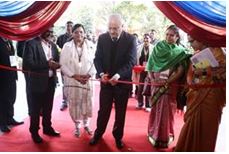



Ongole cattle, originating from Andhra Pradesh, have become Brazil’s prized Nelore breed, valued for meat production and genetic excellence. In India, declining numbers reflect a shift to crossbred cows for milk yield, economic constraints, and cultural factors. To reverse this trend, subsidies, cooperative efforts, and advanced breeding strategies are essential.

Copyright infringement not intended
The Ongole cattle breed originated in Andhra Pradesh (India) has become the most expensive cattle in the world in Brazil.
ONGOLE cattle, also called Ongolu Gitta, have a history dating back to the mid-19th century, with British researchers recording their distinct characteristics, such as a large hump and heat tolerance.
Exported to Brazil as early as 1868, they contributed to Brazil's agricultural revolution. In Brazil, they are now called Nelore, named after the Nellore district, and have become integral to the culture.

Brazil is the world's top beef exporter, utilizing ONGOLE cattle for their meat production. They constitute approximately 80% of Brazil's 225 million cattle, totaling around 180 million Nelore.
ONGOLE cattle success is due to:
The ONGOLE population has declined, from 1.5 million in 1944 to 634,000 in the 2019 Livestock Census. This decline reflects broader trends:
|
ONGOLE cattle linked to Nandi bulls in Shiva temples. Genetically, they offer heat tolerance, disease resistance, and A2 milk potential, which make them valuable for sustainable farming. |
Subsidies for rearing ONGOLE cattle, especially for A2 milk production, which get premiums price over Rs 150/liter.
Involve farmers through cooperatives and awareness campaigns, highlighting cultural and economic benefits.
Expand Rashtriya Gokul Mission (RGM) to focus on ONGOLE, with more Gokul Grams in breeding tracts like Prakasam.
Adopt Brazil's breeding and marketing strategies, potentially exploring export markets for germplasm, subject to policy changes.
Must Read Articles:
Source:
|
PRACTICE QUESTION Q. Consider the following statements in the context of the ONGOLE cattle: 1. ONGOLE cattle are the indigenous breed from Brazil. 2. They constitute approximately 80% of Brazil's cattle. 3. ONGOLE cattle linked to Nandi bulls in Shiva temples. How many of the above statements are correct? A) Only one B) Only two C) All three D) None Answer: B Explanation: Statement 1 is incorrect: ONGOLE cattle, an indigenous breed from India, particularly the Guntur, Prakasam, and Nellore districts of Andhra Pradesh, have seen divergent fortunes in Brazil and India. In Brazil, known as Nelore, they dominate the cattle industry, while in India, they face a decline, prompting conservation efforts. Statement 2 is correct: ONGOLE cattle, also called Ongolu Gitta, have a history dating back to the mid-19th century, with British researchers noting their distinct traits, such as a large hump and heat tolerance. Exported to Brazil as early as 1868, about 7,000 were sent, contributing to Brazil's agricultural revolution. Currently, ONGOLE cattle constitute approximately 80% of Brazil's 225 million cattle, totaling around 180 million Nelore. Statement 3 is correct: ONGOLE cattle hold cultural importance in India, linked to Nandi bulls in Shiva temples, with their hump a distinctive feature. Their global spread, including to the Americas and Africa, highlights their adaptability, yet in India, this potential remains underutilized. |








© 2025 iasgyan. All right reserved